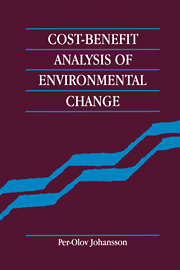Book contents
- Frontmatter
- Contents
- List of figures
- Preface
- 1 Introduction
- 2 Some basic concepts
- 3 Consumer surplus measures
- 4 Valuing public goods: practical methodologies
- 5 General equilibrium cost-benefit rules
- 6 Cost-benefit rules, national income accounts and sustainable development
- 7 Valuation and aggregation: intragenerational and intergenerational issues
- 8 Cost-benefit rules in a risky world
- 9 Valuing changes in access conditions, health risks and information
- 10 Empirical applications
- 11 Policy instruments and international environmental problems
- Notes
- References
- Index
6 - Cost-benefit rules, national income accounts and sustainable development
Published online by Cambridge University Press: 15 January 2010
- Frontmatter
- Contents
- List of figures
- Preface
- 1 Introduction
- 2 Some basic concepts
- 3 Consumer surplus measures
- 4 Valuing public goods: practical methodologies
- 5 General equilibrium cost-benefit rules
- 6 Cost-benefit rules, national income accounts and sustainable development
- 7 Valuation and aggregation: intragenerational and intergenerational issues
- 8 Cost-benefit rules in a risky world
- 9 Valuing changes in access conditions, health risks and information
- 10 Empirical applications
- 11 Policy instruments and international environmental problems
- Notes
- References
- Index
Summary
Thus far we have dealt exclusively with project evaluations in single-period models. This chapter is the first of a sequence dealing with intertemporal problems. In developing the theory it is as well to discuss the simplest considerations first. For this reason the assumption that agents do not face any uncertainty is retained throughout this chapter. In fact, it is assumed that agents have perfect foresight, i.e. know or can calculate all present and future equilibrium prices etc.
Section 6.1 extends the single-period model described in the previous chapter to cover optimization for T-period horizons. Overall or lifetime consumer surplus measures are briefly discussed. Such overall measures, however, require huge amounts of information and may be difficult to calculate and estimate. Therefore, so-called instantaneous consumer surplus measures are introduced, and the question of whether the present value of such surpluses can be used as a proxy for lifetime surplus measures is investigated. Section 6.2 presents intertemporal cost-benefit rules for environmental measures which affect household utility as well as firms' production possibilities. Section 6.3 outlines a cost-benefit analysis of a plant producing ethanol to be used as a motor fuel. The purpose is to illustrate in a simple way how to use the evaluation rules derived in this and the previous chapter. Section 6.4 introduces natural resources and indicates what the cost-benefit rules look like in an economy harvesting both nonrenewable and renewable natural resources. The final section of the chapter is devoted to trade-offs between the interests of the current generation and future generations. A dynamic growth model is used to take a closer look at issues such as cost-benefit rules, national income accounts and sustainable development.
- Type
- Chapter
- Information
- Cost-Benefit Analysis of Environmental Change , pp. 90 - 112Publisher: Cambridge University PressPrint publication year: 1993



